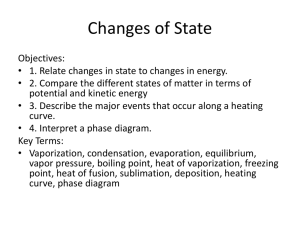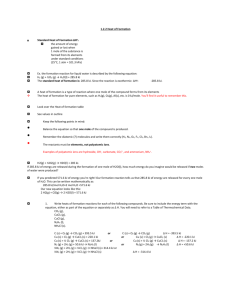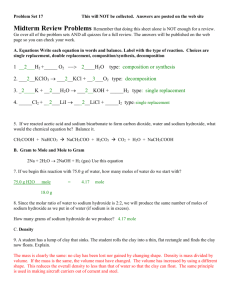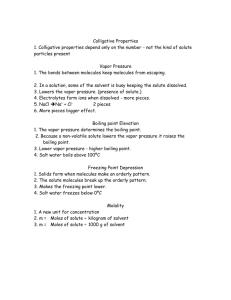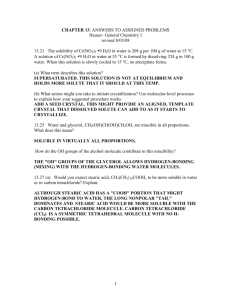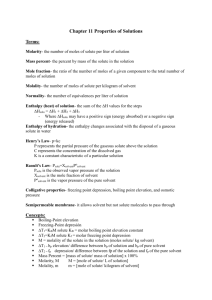Nuclear reactions
advertisement
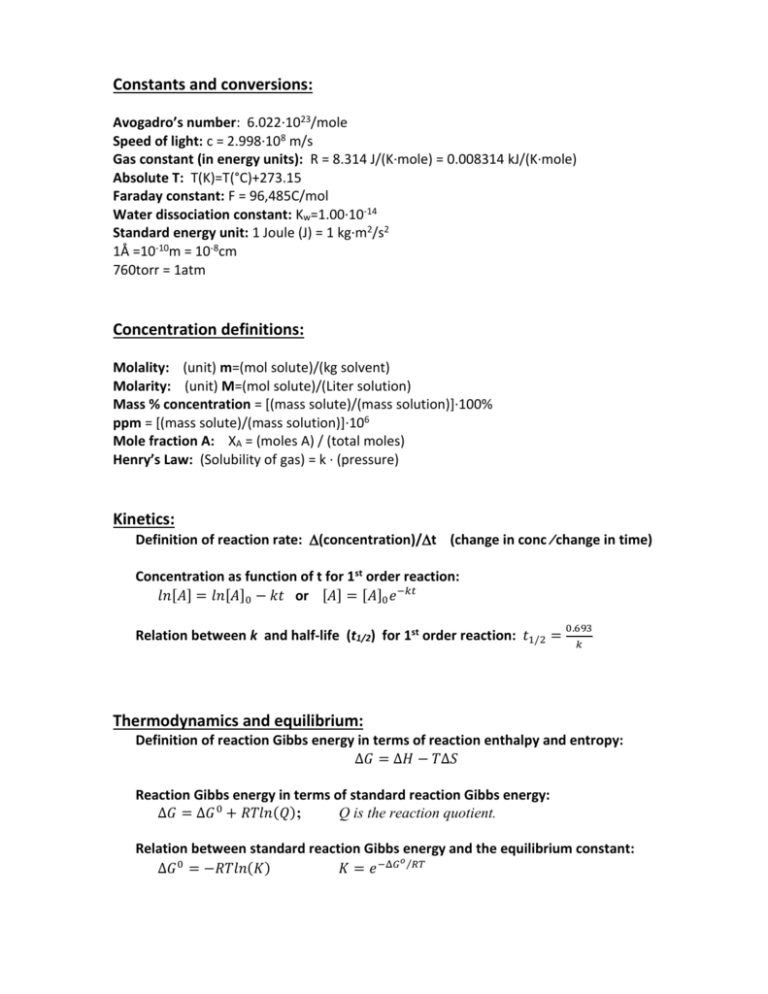
Constants and conversions: Avogadro’s number: 6.022∙1023/mole Speed of light: c = 2.998∙108 m/s Gas constant (in energy units): R = 8.314 J/(K∙mole) = 0.008314 kJ/(K∙mole) Absolute T: T(K)=T(°C)+273.15 Faraday constant: F = 96,485C/mol Water dissociation constant: Kw=1.00∙10-14 Standard energy unit: 1 Joule (J) = 1 kg∙m2/s2 1Å =10-10m = 10-8cm 760torr = 1atm Concentration definitions: Molality: (unit) m=(mol solute)/(kg solvent) Molarity: (unit) M=(mol solute)/(Liter solution) Mass % concentration = [(mass solute)/(mass solution)]∙100% ppm = [(mass solute)/(mass solution)]∙106 Mole fraction A: XA = (moles A) / (total moles) Henry’s Law: (Solubility of gas) = k ∙ (pressure) Kinetics: Definition of reaction rate: (concentration)/t (change in conc ∕change in time) Concentration as function of t for 1st order reaction: 𝑙𝑛[𝐴] = 𝑙𝑛[𝐴]0 − 𝑘𝑡 or [𝐴] = [𝐴]0 𝑒 −𝑘𝑡 Relation between k and half-life (t1/2) for 1st order reaction: 𝑡1/2 = 0.693 𝑘 Thermodynamics and equilibrium: Definition of reaction Gibbs energy in terms of reaction enthalpy and entropy: Δ𝐺 = Δ𝐻 − 𝑇Δ𝑆 Reaction Gibbs energy in terms of standard reaction Gibbs energy: Δ𝐺 = Δ𝐺 0 + 𝑅𝑇𝑙𝑛(𝑄); Q is the reaction quotient. Relation between standard reaction Gibbs energy and the equilibrium constant: 𝑜 Δ𝐺 0 = −𝑅𝑇𝑙𝑛(𝐾) 𝐾 = 𝑒 −Δ𝐺 ⁄𝑅𝑇 Acids and bases: Definition of pH, pOH: pH = -log[H+], pOH = -log[OH-]; pH + pOH=14 Definition of pKa: pKa = -logKa Acid dissociation constant: 𝐾𝑎 = [𝐻 + ][𝐴− ] [𝐻𝐴] Aqueous base dissociation constant: 𝐾𝑏 = or 𝐾𝑏 = [𝐻𝐴][𝑂𝐻 − ] [𝐴− ] [𝐵𝐻 + ][𝑂𝐻 − ] [𝐵] in terms of conjugate acid HA. Water dissociation constant: 𝐾𝑤 = [𝐻 + ][𝑂𝐻 − ]; at standard T, Kw=1.00∙10-14 Henderson-Hasselbach equation for buffers: [𝐴− ] 𝑝𝐻 = 𝑝𝐾𝑎 + 𝑙𝑜𝑔 [𝐻𝐴] Electrochemistry: Galvanic (voltaic) cells Reduction occurs at cathode 0 Cell emf from half-cell potentials: ℰ𝑐𝑒𝑙𝑙 = ℰ 0 (𝑐𝑎𝑡ℎ𝑜𝑑𝑒) − ℰ 0 (𝑎𝑛𝑜𝑑𝑒) Gibbs energy change (= - work available) Δ𝐺 0 = −𝑛𝐹ℰ 0 Units: Joule(J) or kJ n = moles electrons transferred F = Faraday constant = 96, 485 C/mol Equilibrium constant (K): 𝑙𝑛(𝐾) = − Δ𝐺 0 𝑅𝑇 = (charge of one mole of electrons) 𝑛𝐹ℰ 0 𝑅𝑇 R = gas constant in energy units = 8.3145 J/(K∙mol) Nernst equation for non-standard conditions: In terms of reaction quotient Q, and n = number of electrons transferred 𝑅𝑇 𝑙𝑛(𝑄) 𝑛𝐹 A useful form of Nernst equation for standard T (298 K): ℇ𝑐𝑒𝑙𝑙 = ℇ0𝑐𝑒𝑙𝑙 − ℇ𝑐𝑒𝑙𝑙 = ℇ0𝑐𝑒𝑙𝑙 − 0.05916𝑉 𝑙𝑜𝑔(𝑄) 𝑛 Electrolysis Charge 𝒒 = 𝐼 ∙ 𝑡 Units: Coulomb(C) = Amp(A)∙sec(s) Factor relating charge to moles electrons: 1 𝑚𝑜𝑙 𝑒 − ∼ 96,485 𝐶 Nuclear reactions Nuclear decay (same as 1st order kinetics – see above) N=number, concentration, mass, or any measure of amount of nuclear material 𝑙𝑛𝑁 = 𝑙𝑛𝑁0 − 𝑘𝑡 𝑡1/2 = 0.693 𝑘 𝑘= 0.693 𝑡1/2 Mass energy relation: ΔE = Δm𝑐 2 where c = speed of light = 2.998∙108 m/s Units: kg∙m2/s2 = Joule (J) - not kJ Standard reduction potentials: E0 (V) +2.87 Half-Reaction F2(g) + 2 e- -----> F-(aq) H2O2(aq) + 2 H+(aq) + 2 e- -----> 2 H2O PbO2(s) + 4 H + (aq) + SO42-(aq) +1.77 - + 2 e -----> PbSO4(s) + 2 H2O MnO4-(aq) + 8 H+(aq) + 5 e- -----> Mn2+(aq) + 4 H2O 3+ Au - + 3 e -----> Au(s) (aq) + 14 H + (aq) +1.36 - 3+ + 6 e -----> 2 Cr (aq) + 7 H2O O2(g) + 4 H+(aq) + 4 e- -----> 2 H2O - +1.51 +1.50 Cl2(g) + 2 e- -----> 2 Cl-(aq) Cr2O72-(aq) +1.70 - +1.33 +1.23 Br2(l) + 2 e -----> 2 Br (aq) +1.07 NO3-(aq) +0.96 +4H + (aq) - + 3 e -----> NO(g) + 2 H2O Ag+(aq) + e- -----> Ag(s) 3+ Fe - 2+ + e -----> Fe (aq) (aq) MnO4-(aq) + 2 H2O + 3 e- -----> MnO2(s) + 4 OH-(aq) - - +0.80 +0.77 +0.59 I2(s) + 2 e -----> 2 I (aq) +0.53 Cu2+(aq) + 2 e- -----> Cu(s) +0.34 2+ Cu + 2H (aq) (aq) - + e -----> Cu + (aq) - + 2 e -----> H2(g) Pb2+(aq) + 2 e- -----> Pb(s) Ni 2+ (aq) - + 2 e -----> Ni(s) PbSO4(s) + 2 e- -----> Pb(s) + SO42-(aq) 2+ Fe - +0.13 0.00 -0.13 -0.25 -0.31 + 2 e -----> Fe(s) -0.44 Cr3+(aq) + 3 e- -----> Cr(s) -0.74 Zn2+(aq) + 2 e- -----> Zn(s) -0.76 (aq) - -1.66 Mg2+(aq) + 2 e- -----> Mg(s) -2.37 Al 3+ + Na (aq) (aq) + 3 e -----> Al(s) - + e -----> Na(s) Ca2+(aq) + 2 e- -----> Ca(s) + K Li (aq) + (aq) -2.71 -2.87 - -2.93 - -3.05 + e -----> K(s) + e -----> Li(s)




